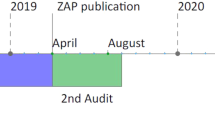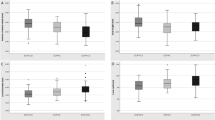Abstract
Objective
Can anterior segment optical coherence tomography (AS-OCT) replace gonioscopy as the preferred triage tool for angle assessments in virtual glaucoma clinics?
Subjects/Methods
Every new referral into Sheffield Teaching Hospital’s glaucoma service over a five-month period were subject to gonioscopy and AS-OCT assessment of their angles. Appropriately trained ophthalmic science practitioners (OSPs) performed the gonioscopy and labelled angles as ‘open’ or ‘closed’. Two glaucoma-subspecialty ophthalmologists reviewed the AS-OCT images independently on a different day and graded the angles as ‘open’ or ‘closed’.
Results
There was an angle assessment of 384 eyes, with statistical analysis of 358 eyes due to 26 eyes being unable to have gonioscopy. AS-OCT was found to have a sensitivity of 97.11% ± 1.32% and a specificity of 36.17% ± 9.71% for identifying an open angle. The positive predictive value of the test was 95.70% ± 0.63%, while the negative predictive value was 46.08% ± 13.13%.
Conclusions
As a triage tool, specialist assessment of the angle on AS-OCT is a safe, effective alternative to OSP-led gonioscopy.
This is a preview of subscription content, access via your institution
Access options
Subscribe to this journal
Receive 18 print issues and online access
$259.00 per year
only $14.39 per issue
Buy this article
- Purchase on SpringerLink
- Instant access to full article PDF
Prices may be subject to local taxes which are calculated during checkout
Similar content being viewed by others
Data availability
All data supporting the findings of this study are available within the paper and its Supplementary Information.
References
The Royal College of Ophthalmologists. The way forward, glaucoma. 2021. Available from: https://www.rcophth.ac.uk/wp-content/uploads/2021/12/RCOphth-The-Way-Forward-Glaucoma-300117.pdf. Last accessed February 2025.
Khawaja AP, Sherratt MA, Sparrow JM. The Royal College of Ophthalmologists’ glaucoma commissioning guidance: executive summary. Eye. 2017;31:818–22.
Chalk D, Smith M. Guidelines on glaucoma and the demand for services. British J Healthc Manag. 2013;19:476–81.
The Royal College of Ophthalmologists. Standards for virtual clinics in glaucoma care in the NHS Hospital Eye Service. 2016. Available from: https://www.rcophth.ac.uk/wp-content/uploads/2021/01/Virtual-Glaucoma-Clinics.pdf. Last accessed February 2025.
Foot B, MacEwen C. Surveillance of sight loss due to delay in ophthalmic treatment or review: frequency, cause and outcome. Eye. 2017;31:771–5.
Sen S, Das M, Das MK, Dash S. Challenges in managing glaucoma-related morbidity due to lockdown in a developing country. J Fam Med Prim Care. 2022;11:1410–5.
Gan K, Liu Y, Stagg B, Rathi S, Pasquale LR, Damji K. Telemedicine for glaucoma: guidelines and recommendations. Telemed e-Health. 2020;26:551–5.
Gunn PJ, Marks JR, Au L, Waterman H, Spry PG, Harper RA. Acceptability and use of glaucoma virtual clinics in the UK: a national survey of clinical leads. BMJ open Ophthalmol. 2018;3:e000127.
Heimann H, Broadbent D, Cheeseman R. Digital ophthalmology in the UK–diabetic retinopathy screening and virtual glaucoma clinics in the National Health Service. Klinische Monatsblätter für Augenheilkd. 2020;237:1400–8.
National Institute for Health and Care Excellence. Glaucoma: diagnosis and management. 2017. Available from: https://www.nice.org.uk/guidance/ng81/resources/glaucoma-diagnosis-and-management-pdf-1837689655237. Last accessed February 2025.
Rodriguez-Una I, Azuara-Blanco A. New technologies for glaucoma detection. Asia-Pac J Ophthalmol. 2018;7:394–404.
Faschinger C, Anton H. Gonioscopy. 1st ed. Berlin; Springer Science & Business Media; 2012, p 9.
Javed A, Loutfi M, Kaye S, Batterbury M. Interobserver reliability when using the Van Herick method to measure anterior chamber depth. Oman J Ophthalmol. 2017;10:9–12.
Li H, Leung CK, Cheung CY, Wong L, Pang CP, Weinreb RN, et al. Repeatability and reproducibility of anterior chamber angle measurement with anterior segment optical coherence tomography. Brit J Ophthalmol. 2007;91:1490–2.
Ying GS, Maguire MG, Glynn RJ, Rosner B. Calculating sensitivity, specificity, and predictive values for correlated eye data. Investig Ophthalmol Vis Sci. 2020;61:29.
Jain N, Zia R. Estimating the prevalence of narrow anterior chamber angles in Caucasian populations. Investig Ophthalmol Vis Sci. 2020;61:46.
StatPearls. Diagnostic testing accuracy: sensitivity, specificity, predictive values and likelihood ratios. 2023. Available from: https://www.ncbi.nlm.nih.gov/books/NBK557491. Last accessed February 2025.
Jindal A, Ctori I, Virgili G, Lucenteforte E, Lawrenson JG. Non-contact tests for identifying people at risk of primary angle closure glaucoma. Cochrane Database Syst Rev. 2020;5:CD012947.
González-Pérez J, Queiruga Piñeiro J, Sánchez García Á, González Méijome JM. Comparison of central corneal thickness measured by standard ultrasound pachymetry, corneal topography, tono-pachymetry and anterior segment optical coherence tomography. Current Eye Res. 2018;43:866–72.
Azuara-Blanco A, Lawrenson JG, King AJ, Foster PJ, Virgili G, Guiney M, et al. Technologies for the diagnosis of angle closure glaucoma (ACE): protocol of a prospective, multicentre, cross-sectional diagnostic study. BMJ Open. 2023;13:e073975.
Acknowledgements
The authors would like to acknowledge the mathematics students of High Storrs School, Sheffield. Under the guidance of their statistician teacher Mr Ben Lowe, they engaged in developing the statistical analysis of the paper.
Author information
Authors and Affiliations
Contributions
GA was responsible for designing the study, registering it with the University of Sheffield Clinical Research and Innovation Office, ensuring the design passed Independent Scientific Review, reviewed the completed manuscript and offered feedback. GA and JP analysed the AS-OCT images as per the study design. JP also reviewed the completed manuscript and offered feedback. TE created the AS-OCT scan reports, assigned the data for analysis, coordinated to ensure AS-OCT image analysis was blinded and independent between the two assessors, collated the data for analysis, reviewed the completed manuscript and offered feedback. AD analysed the data, interpreted the results and wrote the manuscript. There was no use of Artificial Intelligence (AI) Assisted Technology at any point through the study or writing of the manuscript.
Corresponding author
Ethics declarations
Competing interests
The authors declare no competing interests.
Additional information
Publisher’s note Springer Nature remains neutral with regard to jurisdictional claims in published maps and institutional affiliations.
Supplementary information
Rights and permissions
Springer Nature or its licensor (e.g. a society or other partner) holds exclusive rights to this article under a publishing agreement with the author(s) or other rightsholder(s); author self-archiving of the accepted manuscript version of this article is solely governed by the terms of such publishing agreement and applicable law.
About this article
Cite this article
Dhalla, A., Evans, T., Pilling, J. et al. Comparison of anterior segment optical coherence tomography versus technician led gonioscopy as a triage tool for anterior chamber angle status. Eye 39, 2474–2478 (2025). https://doi.org/10.1038/s41433-025-03906-y
Received:
Revised:
Accepted:
Published:
Issue date:
DOI: https://doi.org/10.1038/s41433-025-03906-y



